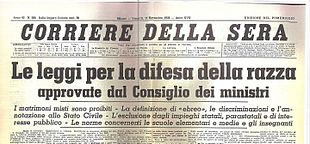Manifesto of Race
This article includes a list of general references, but it lacks sufficient corresponding inline citations. (September 2022) |

The "Manifesto of Race" (Italian: "Manifesto della razza"), otherwise referred to as the Charter of Race or the Racial Manifesto, was an Italian manifesto promulgated by the government of Benito Mussolini on 14 July 1938. Its promulgation was followed by the enactment, in October 1938, of the Racial Laws in Fascist Italy and the Italian Empire.[1][2]
The
History
| ||
|---|---|---|
|
||
Prior to 1938 there had not been any race laws promulgated in the Kingdom of Italy during the previous years of Benito Mussolini's dictatorship (1922 onwards). Mussolini had held the view that a small contingent of Italian Jews had lived in Italy "since the days of the Kings of Rome" (a reference to the Benè Romi, or Italian-rite Jews) and should "remain undisturbed".[3] There were even some Jews in the National Fascist Party, such as Ettore Ovazza who in 1935 founded the Jewish Fascist paper La Nostra Bandiera.[7] Among the 180 signers of the "Manifesto of Race" were two medical doctors (S. Visco and N. Fende), an anthropologist (L. Cipriani), a zoologist (E. Zavattari), and a statistician (F. Savorgnan).[8]
In recognition of both their past and future contributions and for their service as subjects of the
On 13 July 1938 the Kingdom of Italy promulgated a publication mistitled "Manifesto of the Racial Scientists"[11] which mixed
Motivations

The
After considerable resistance, Nazi influence began to penetrate some intellectual circles in the Kingdom of Italy. In general, however, there was a concerted effort to distinguish Fascist "racism", allegedly of "culturalist" variety, from that emanating from the Germanic realm.
Criticism and unpopularity
For the most part, the Racial Laws were met with disapproval from not just ordinary Italian citizens but also members of the National Fascist Party themselves. On one occasion, an Italian Fascist scholar questioned Mussolini over the treatment his Jewish friends were receiving after the promulgation of the Racial Laws, which prompted Mussolini to say: "I agree with you entirely. I don't believe a bit in the stupid anti-Semitic theory. I am carrying out my policy entirely for political reasons."
Indeed, prior to 1938 and the Pact of Steel alliance, Mussolini and many notable Italian Fascists had been highly critical of
In 1929, Mussolini noted that Italian Jews had been a demographically small yet culturally integral part of Italian society since Ancient Rome. His views on Italian Jews were consistent with his early
See also
References
- ^ S2CID 201401541.
- ^ OCLC 1122565258.
- ^ ISBN 0-8039-4648-1. Archived from the original(PDF) on 15 May 2008.
- ISBN 9780803946484.
- ^ "INTERNATIONAL: Pax Romanizing - TIME". www.time.com. Archived from the original on 25 November 2010. Retrieved 27 April 2022.
- ^ "Thirty centuries of history allow us to look with supreme pity on certain doctrines which are preached beyond the Alps by the descendants of those who were illiterate when Rome had Caesar, Virgil, and Augustus".
- ^ "The Italian Holocaust: The Story of an Assimilated Jewish Community". ACJNA.org. 8 January 2008.
- ISBN 9788816409071.
- ISBN 978-0-230-80267-4.
- ISBN 978-0-521-84515-1.
- ^
Duranti, Simone (24 May 2005). "Manifesto of the Racial Scientists (1938)". In ISBN 9781851094394. Retrieved 6 August 2023.
Promulgated on July 13, 1938, in Italy and published in all the national papers on the following day, the ten proposals enunciated in the Manifesto degli scienziati razzisti (Manifesto of the Racial Scientists) represented the Fascist Party's official theoretical position on race. [...] Purportedly written by a group of Fascist intellectuals, lecturers within the Italian universities and coordinated by the Ministry of Popular Culture, the Manifesto was, in fact, put together by Guido Landra, a lowly teaching assistant in the Anthropology Department of Rome University [...].
- ^ Joshua D. Zimmerman, Jews in Italy Under Fascist and Nazi Rule, 1922-1945, pp. 119-120
- ^ Livingston, p. 17.
- ^ Livingston, p. 67.
- ISBN 978-0-521-84101-6.
- ISBN 0-02-864214-7
- ^ Gregor, 56
- ^ Christopher Hibbert, Benito Mussolini, p. 110.
- ^ ISBN 978-9004212558. Retrieved 9 January 2016.
- ^ a b Neocleous, Mark. Fascism. Minneapolis, Minnesota, USA: University of Minnesota Press, 1997. p. 35
- ISBN 978-0618794263.
Sources
- Livingston, Michael A. The Fascists and the Jews of Italy: Mussolini's Race Laws, 1938-1943.
- Gregor, A. James; The Search for Neofascism, New York, Cambridge University Press (2006). ISBN 978-0-521-85920-2
- Gregor, A. James; Mussolini's Intellectuals: Fascist Social and Political Thought, Princeton, Princeton University Press (2005).
- Wiskemann, Elizabeth; Fascism in Italy: Its Development and Influence, New York, St. Martins Press (1969).
- Renzo De Felice: The Jews in Fascist Italy. Enigma Books 2001, ISBN 1-929631-01-4.
External links
- "Il manifesto della Razza – 1938" (in Italian). Rome: Associazione Nazionale Partigiani d'Italia. 21 March 2016. Archived from the original on 4 February 2022. Retrieved 15 May 2022.
- Adler, Franklin H. (Fall 2013). from the original on 30 March 2014. Retrieved 15 May 2022.

